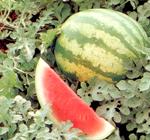| Fruits |
Vegetables
|
Watermelon, Citrullus lanatus / Cucurbitaceae
|
Note: Composition for 100 g. of fresh product Values in ( min. - max. ) format. | |
| Energy: 25.00-37.36 kcal Fats: 0.20-0.20 g Fibres: 0.22-0.22 g Minerals Calcium: 10.00-10.50 mgZinc: 0.275-0.275 mg Chlorine: 8.30-8.30 mg Phosporus: 5.00-11.00 mg Iron: 0.300-0.400 mg Magnesium: 2.90-2.90 mg Potasium: 158.00-158.00 mg Selenium: 0.400-0.400 µg Sodium: 0.500-0.500 mg Iodine: 1.00-1.00 µg | Proteins: 0.40-0.60 kcal Carbohidrates: 550-8.29 g Liposoluble Vitamins A Retinol: 86.67-86.67 µgA Carotenoids: 300.00-795.00 µg Liposoluble Vitamins B1 or Thiamine: 0.020-0.045 mgB2 or Riboflavine: 0.0090-0.050 mg B3 or Niacine: 0.10-0.10 mg B5 or Pantothenic Acid: 1.60-1.60 mg B6 or Piridoxine: 0.070-0.070 mg B9 or Folic Acid: 4.00-6.00 mg C or Ascorbic Acid: 4.00-6.00 mg |

The watermelon is a large fruit of a more or less spherical shape. It is usually eaten raw as table dessert. It has a sweet reddish or yellowish flesh. It is a very refreshing food that supplies very few calories. It also provides some vitamins and minerals.
Nutrition and eating
The watermelon has various healing properties for which the pulp, the rind or the seeds are used. It is suitable to treat sunstroke, hypertension or pharyngitis, among other diseases. It is widely used in several American countries for its healing properties.
The fruit
 The watermelon is a large fruit of a more or less spherical shape. It is usually eaten raw as table dessert. It has a sweet reddish or yellowish flesh. It is a very refreshing food that supplies very few calories. It also provides some vitamins and minerals.
The watermelon is a large fruit of a more or less spherical shape. It is usually eaten raw as table dessert. It has a sweet reddish or yellowish flesh. It is a very refreshing food that supplies very few calories. It also provides some vitamins and minerals.The watermelon is a large fruit, up to 25cm of diameter, in some cases weighing up to 15kg. It has an oval or spherical shape and a dark green and smooth rind, sometimes showing irregular areas of a pale green colour. It has a sweet, juicy, refreshing flesh of yellowish or reddish colour, containing multiple black, brown or white pips. Some new varieties, cultivated in the last few years, have changed this classic characteristic, bearing seedless fruits, varieties of yellow pulp or smaller watermelons.
The watermelon is generally eaten raw, in slices, quarters or even in small balls. It is used to make sherbets, puree and jam. In Russia they prepare a very popular wine of watermelon juice. The rind is sometimes used to make comfiture or sweet brine and in the rural media it is cattle food. In some regions, the pips are consumed roasted or salted.
It is very rich in water; it hardly contains fats nor proteins, and therefore it is low in calories. Moreover, it is an important source of potassium and vitamin A. It is a refreshing fruit with diuretic properties.
The plant

The watermelon is a crawling and climbing plant with lengthy stems and leaves divided in lobes. Its fruit is a berry that may weigh up to 15kg, with a hard green rind and a sweet pulp of more or less reddish colour.
The watermelon is an annual plant that belongs to the family of Cucurbitaceous. Its scientific name is Citrullus vulgaris. It has some herbaceous stems that may reach 5m of length. They are cylindrical, with longitudinal and hairy furrows.
The upper side of the leaves is very smooth, whereas the reverse is very rough, with strongly marked nerves. The leaves are divided in rounded segments, each one with 3 to 5 lobes.
The flowers are born in the axils of the leaves. They are yellow and solitary, masculine and feminine. They are pollinated by insects. The feminine flowers give rise to the watermelons, that are great berries of more or less spherical shape and variable size, that weigh between 2 and 15kg. The pulp is of pink or reddish colour, containing multiple squashed seeds of variable colour (brown, black, white, etc.). The rind is smooth or with clearer streaks and its colour ranges from dark green to pale green.
At present, and due to the attack of various ground diseases, specially the fungus Fusarium oxysporum, watermelons are root-grafted on another plant resistant to this parasite. For this purpose, they use species similar to the watermelon, like Cucurbita ficifolia, Benincasa cerifera or Cucurbita moschata, all of them belonging also to the family of Cucurbitaceous.
The watermelon is an annual plant that belongs to the family of Cucurbitaceous. Its scientific name is Citrullus vulgaris. It has some herbaceous stems that may reach 5m of length. They are cylindrical, with longitudinal and hairy furrows.
The upper side of the leaves is very smooth, whereas the reverse is very rough, with strongly marked nerves. The leaves are divided in rounded segments, each one with 3 to 5 lobes.
The flowers are born in the axils of the leaves. They are yellow and solitary, masculine and feminine. They are pollinated by insects. The feminine flowers give rise to the watermelons, that are great berries of more or less spherical shape and variable size, that weigh between 2 and 15kg. The pulp is of pink or reddish colour, containing multiple squashed seeds of variable colour (brown, black, white, etc.). The rind is smooth or with clearer streaks and its colour ranges from dark green to pale green.
At present, and due to the attack of various ground diseases, specially the fungus Fusarium oxysporum, watermelons are root-grafted on another plant resistant to this parasite. For this purpose, they use species similar to the watermelon, like Cucurbita ficifolia, Benincasa cerifera or Cucurbita moschata, all of them belonging also to the family of Cucurbitaceous.
| Interempresas Media, S.L. / 2026 | [ Legal notice | Política de Protección de Datos | Política de cookies | Publicidad] |
